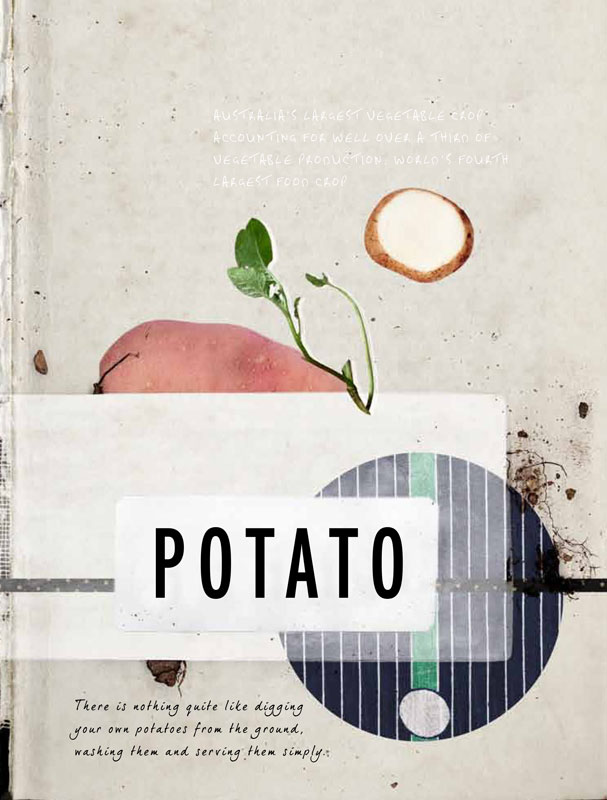
Where to start, with a vegetable like the perfect potato? The potato is to the Western world what rice is to the East. An irreplaceable staple, loved, respected and revered.
RECIPES
THE BEST SIMPLE LITTLE ROAST SPUDS
BRAISE OF FINGERLING POTATOES WITH SEA BASS
WINTER SALAD OF FINGERLING & PURPLE CONGO POTATOES, CAPOCOLLO & TRUFFLE
My first experience in the world of cooking and learning how to construct a dish was being told to think of the protein component, think about which way to cook the potato to go with it, and then think about what other vegetables to include. There was no question of not using potato. When I was first learning to cook we just used potatoes with everything. Even now, when there are so many different starches I like to use (rice or grains, for instance), it is still one of my favorite things. Who doesn’t love thinly sliced potatoes, cooked through with cream, thyme and garlic, pressed into a dauphinoise? It’s a classic.
But then, there is nothing finer than perfect mashed potato. And I’m not talking instant mash, but a proper mash, creamy and perfectly seasoned. The secret is in the ratio: 50 per cent potato to 50 per cent butter, with a bit of milk to bind it. It’s not diet food, obviously but, if you are going to indulge every once in a while, then do it properly. Thin it out with a bit of milk and season with salt, but no pepper. It’s the best mash ever, I promise you—give it a go. And trust me on the no-pepper thing.
The potato arrived in Europe from the Andean region of South America, thanks to the Spanish conquerors around the late 1500s, who referred to them as “patatas.” Though they were originally viewed with great suspicion (as something on the verge of being outright poisonous), by the 1700s they had begun to be accepted, grown in many countries and widely used.
So it has only been around for about 400 years. That’s all the time that we have had them. It’s almost unbelievable because, like the tomato, they have become so invaluable to us in that period. During that time, potatoes have become essential to the lives of entire populations. In Prussia, after the great famine of 1774, Frederick the Great recognized the potato’s potential to save his people from starvation, and so ordered them to be sent to the populace for free.
In Ireland, the potato was recognized very early for its high yield for very little labor—an acre (⅖ hectare) of potatoes was enough to feed a family of six for a year. The Irish tenant farmers were, at the time, some of the poorest people in the Western world, and this vegetable was seen as a godsend, allowing them to work their land and provide sustenance for their families. That is until 1845 when disease, potato blight, caused the year’s crop to fail and the subsequent deaths of more than one million Irish due to starvation over the next six years. As a result, one million Irish migrated to the Americas, leaving Ireland a shell of its former self. All those jokes about the Irish and their love and dependency on the potato. When you put it into context, it isn’t really a laughing matter.
When I was a kid, we always grew potatoes. Dad always had them in the garden. And we were lucky because in the UK, we experienced three seasons every year compared to areas like Scandinavia or Russia, where it’s so cold they only enjoy one. Perhaps that’s why I thought it would be a good idea to get a job in my early teens on a big potato farm just outside of Penistone, near Barnsley.
I lasted one day. I was getting paid around one-and-a-half pounds an hour to dig potatoes, and I am not exaggerating when I say it was the hardest, most rubbish job in the world.
Still, we’re not talking commercial scale if you want to grow a few in the backyard. And there is nothing quite like digging your own potatoes from the ground, washing them and serving them simply—boiled and smashed with a bit of good olive oil, chardonnay vinegar, salt and fresh herbs. Perfect.
One thing I will recommend is to put them in only one area of your garden only. Go to a nursery or garden center and invest in a potato sack or bed exclusively for potatoes because once they are in they will simply keep growing. For example, at my new house I put a new garden bed in and I virtually sifted the soil to make sure it was nice and clean to start. But I must have missed one or two little potatoes (probably no bigger than the size of my pinky fingernail) and, within the space of a few months, I had potatoes everywhere again. Once they’re in, they’re in. I saw a great technique on an old farm in Derbyshire, UK, where the farmer had collected old truck tyres, filled them full of soil and used those to contain the potatoes and stop them spreading throughout the entire garden.
One thing that may hold people back is what variety to plant or use. There are so many, literally thousands of, potato varieties worldwide, and around 500 available for a home gardener to grow. So when you are choosing potatoes, look for the best type for what you want to do. If you are at the supermarket or grocer, talk to the produce people. If you’re at a farmers’ market, take the chance to talk to a farmer. It really makes such a difference to your dish to pick the right one for the right purpose. It’s comparable in cooking terms with apples, with the French referring to the potato as the “pomme de terre” (the apple of the earth) because, like the apple, potatoes have different varieties that are better suited to different cooking methods. As with apples, you have baking, cooking and eating ones, and it’s the same with the potato. Some are good “all rounders,” like the Desiree, Coliban or Royal Blue. Some are better for mashing, like the King Edward. For boiling, try the Pink Fir Apple, Fingerling or Nicola varieties, especially if you’re wanting to make a salad. The Toolangi Delight is a variety that is excellent to bake for a nice light gnocchi. If you’re wanting to fry a good homemade chip, variety is all important, because the outcome depends on the level of starch within a particular variety. And I have found that the Russet Burbank, Golden Wonder and Yukon Gold are the kings of frying potatoes. Unfortunately, for the general populace, the big fast-food chains know this as well and secure around 90 per cent of the crop for their fries. No wonder we love them so much!
THE BEST SIMPLE LITTLE ROAST SPUDS
SERVES 4
Look out for small cocktail potatoes, weighing about 1½ ounces each, to make this simple recipe. I’d recommend either fingerlings or marble-sized new potatoes.
20 SMALL POTATOES
½ CUP FATBACK (OR OLIVE OIL IS THE HEALTHIER OPTION)
SEA SALT OR HERB SALT (SEE RECIPE)
Preheat the oven to 500°F
Wash the potatoes with a sponge, but don’t scrub them too hard as you really want to keep the skin, then dry them off with a tea towel. Place in a saucepan, making sure you have at least 2 inches from the top, and fill with enough cold water to just cover the potatoes. Bring to a boil over high heat, then continue to cook for 5 minutes. Drain and let the steam evaporate.
Meanwhile, place the fat in a deep-sided heavy-bottomed roasting tray and heat in the oven for 2–4 minutes. Take the tray out, add the potatoes and place back into the oven. Turn down the oven temperature to 425°F and continue baking for 35–50 minutes, shaking the tray every 8 minutes or so. Take out of the oven and drain off the excess fat. Sprinkle with salt or herb salt if you have some handy.
BRAISE OF FINGERLING POTATOES WITH SEA BASS
SERVES 4
This recipe is so adaptable, for many reasons. It is so delicious and, although it is quite rich, it is one of my favorite dishes to eat in any weather or season. For the spuds, you can use any good waxy small potato that likes to be braised. You can also take out the sea bass and tomatoes or replace it with another fish, but it has to be a meaty one—you know the types: ones that will not dry out easily when braised, such as cod. Now you’re asking what this goes with? Well, I’m not going to tell you but here’s a clue—have a look through the rest of the book and decide what recipe it may marry well with. Or eat simply with some couscous or even a little polenta.
¾ CUP EXTRA VIRGIN OLIVE OIL
2 LARGE WHITE ONIONS, HALVED AND THINLY SLICED
6 SMALL FINGERLING POTATOES, WASHED AND SLICED TO THE THICKNESS OF A BEER-BOTTLE TOP
2 TOMATOES, PREFERABLY HEIRLOOMS OF ANY VARIETY, OTHERWISE PLUMS, ROUGHLY CHOPPED
SEA SALT AND FRESHLY GROUND BLACK PEPPER
1 POUND 5 OUNCES SEA BASS (ASK YOUR FISHMONGER TO REMOVE ALL SKIN AND BONE), CUT INTO 7 × 2¾ INCH PORTIONS (SEE NOTE)
3 TABLESPOONS SALTED BABY CAPERS, RINSED
JUICE OF 1 LEMON
½ BUNCH ITALIAN PARSLEY, LEAVES PICKED AND ROUGHLY CHOPPED
Heat a heavy-bottomed saucepan (measuring 10½ inches in diameter by 6¼ inches deep) over medium heat. Add the olive oil and heat for 3 minutes, then add the onion and cook, stirring occasionally, for 8 minutes or until they start to break down but have not started to color. Add the potato and cook, stirring occasionally, for 10 minutes. Add the tomato and cook, stirring occasionally, for 5 minutes or until it starts to break down. At this point, season with salt and pepper, increase the heat to high, add 2⅔ cups of council pop (as my grandfather use to say, that is water) and bring to a boil. Turn down to low heat and cook out for 15–20 minutes or until the potatoes are cooked.
Now add the sea bass, turn up the heat to high and cook for 4 minutes. Take the pan immediately off the heat, stir in the capers, cover with a lid and set aside for 10–15 minutes.
Take the lid off and have a look to see if the fish is cooked. If it’s ready, check the seasoning and put back over medium to gently heat. Add the lemon juice and parsley and serve.
Note If you can’t get sea bass, give cod or maco shark a try.
“SHEPHERD’S PIE” CROQUETTES
MAKES 30–50 (DEPENDING ON YOUR PREFERRED SIZE)
Okay, so it ain’t literally a shepherd’s pie but all the ingredients are what you would put into one. Cooking lamb shoulder slowly in a slow cooker is a great way to make the most of this cut. The croquettes make a lovely canapé, snack or side for a main of lamb, of course. However, they are a little time consuming so don’t try them when you get home from work—give ’em a go on your day off instead.
1 POUND 12 OUNCES BONELESS LAMB FOREQUARTER SHOULDER
1 CARROT, PEELED AND DICED
1 SMALL TURNIP, PEELED AND DICED
1 WHITE ONION, QUARTERED
2 POUNDS 4 OUNCES MASHED POTATO (WITH NOTHING ADDED BUT MAKE SURE IT IS STILL WARM)
2 TABLESPOONS DIJON MUSTARD
4 TABLESPOONS MELTED DUCK FAT, COOLED TO ROOM TEMPERATURE (OR OLIVE OIL)
1 CUP CHOPPED ITALIAN PARSLEY
SEA SALT AND FRESHLY GROUND BLACK PEPPER
3 TABLESPOONS SHERRY VINEGAR
⅔ CUP ALL-PURPOSE FLOUR
8 FREE-RANGE OR ORGANIC EGGS, LIGHTLY BEATEN
10 CUPS FRESH BREAD CRUMBS (MADE FROM 2 LOAVES OF CRUSTLESS WHITE BREAD)
VEGETABLE OIL, FOR DEEP-FRYING
Place the lamb shoulder, carrot, turnip and onion in a slow cooker and cover with water. Cook on high for 7 hours. Once cooked, cool slightly, then take out the meat and shred into a bowl. Pass through a strainer, discarding the cooking liquid. Add the vegetables to the bowl. Mix in the remaining ingredients, then shape about ¼ cup of the mixture into croquettes. This will make 30 or you could make them a bit smaller to yield 50.
To crumb, place the flour, eggs and 1⅔ cups of the bread crumbs in separate bowls. Dip a croquette into the flour, then into the egg, then the bread crumbs and place on a tray. Repeat with the remaining croquettes, topping up the bread crumbs as needed as they get a bit messy from the egg. After you have crumbed all the croquettes, repeat dipping in the egg and bread crumbs again so they are double crumbed.
Heat the oil in a deep-fryer to 350°F or in a deep saucepan (no more than one-third full) and deep-fry the croquettes, in batches, for 2–3 minutes or until golden and hot on the inside. Sprinkle with salt (or herb salt) and serve straight away.
WINTER SALAD OF FINGERLING & PURPLE CONGO POTATOES, CAPOCOLLO & TRUFFLE
SERVES 4 AS AN ENTRÉE OR A SALAD OR SIDE TO SHARE
I have to admit, if you do have a spare truffle hanging around, this dish bloody rocks with it shaved over… But if you don’t, it’s lovely just as is. This salad must be served warm to get the best flavor out of the potatoes.
6 SMALL FINGERLING POTATOES, WASHED AND CUT INTO ½ INCH THICK SLICES
6 SMALL PURPLE CONGO POTATOES, WASHED AND CUT INTO ½ INCH THICK SLICES
1 QUANTITY TARRAGON EMULSION (SEE RECIPE)
1 QUANTITY PARSNIP SKORDALIA (SEE RECIPE)
8 THIN SLICES CAPOCOLLO (USE PROSCIUTTO OR SALAMI IF YOU CAN’T FIND IT)
2 TABLESPOONS SALTED BABY CAPERS, RINSED AND CHOPPED
1 BUNCH PARSLEY SHOOTS, TRIMMED (OR FINELY CHOPPED ITALIAN PARSLEY)
⅓ CUP EXTRA VIRGIN OLIVE OIL
SEA SALT AND FRESHLY GROUND BLACK PEPPER
1 SMALL WINTER TRUFFLE
Place the two types of potatoes each in a large saucepan, add enough cold water to just cover and add some salt. Bring to a boil, then turn down the heat to a simmer and cook for 5–7 minutes or until just cooked. Insert the tip of a sharp knife into the potato slices to check if they’re ready; if the knife goes in easily, they’re cooked. Drain straight away and place in a bowl. Toss with some of the tarragon emulsion so they are really well coated and leave to sit for 1 minute. Spread or spoon some of the skordalia over the base of a large serving plate, spoon the potato on top, scatter over the capocollo, capers and parsley shoots, drizzle with the olive oil, season with salt and pepper and finely shave the truffle over the top to finish.
Note Capocollo is cured, air-dried rolled pork. It’s available from good Italian delicatessens.
MAKES ABOUT 1 CUP
This makes an amazing salad dressing for all sorts of things.
1½ TABLESPOONS DIJON MUSTARD
3 TABLESPOONS CHARDONNAY VINEGAR
2 TABLESPOONS TARRAGON VINEGAR
⅓ CUP GRAPESEED OIL
2 TEASPOONS CHOPPED TARRAGON
Whisk together the mustard, vinegars and oil until emulsified, then stir through the tarragon.
POTATO SCALLOPS
MAKES 20
We’ve all seen them before, usually in a hot-food display cabinet at a takeaway food shop. I have to own up that my school-dinner money went to buying potato scallops from the local fish shop. I love them. This recipe is adapted from a small element of a dish that I used to make at Vue de Monde. Okay, so it’s junkfood, but million-dollar junkfood done this way. And, if you’re flush, buy a winter truffle, thinly slice it and put a slice on each side of the scallop before battering and deep-frying.
3 LARGE ALL-PURPOSE POTATOES
3¼ CUPS LIGHT CREAM
2 PINCHES OF FINE SEA SALT
30 TURNS OF WHITE PEPPER FROM A MILL
VEGETABLE OIL, FOR DEEP-FRYING
HERB SALT (SEE RECIPE), TO SERVE
1⅓ CUPS ALL-PURPOSE FLOUR
1½ CUPS CORNSTARCH
3 TABLESPOONS BAKING POWDER
FINE SEA SALT
ABOUT 2 CUPS SPARKLING MINERAL WATER
Preheat the oven to 450°F. Line the base and sides of a baking sheet (measuring 10½ × 8 × 2½ inches) with parchment paper. Give the potatoes a quick wash, leave the skin on, top and tail them, then slice into ½ inch thick slices. You should get roughly 20 slices. Place the cream in a 8-cup capacity saucepan and bring to a boil, stirring occasionally. Take off the heat and season with salt and pepper. Pour into the baking sheet, arrange the potato slices in the tray, cover with foil, pierce the foil with 5 holes and bake for 30 minutes. Insert a skewer through the sliced potato to test if it is cooked—it should give a bit of resistance. Take out of the oven and leave to cool.
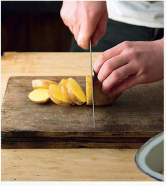
1 Slice the potatoes.
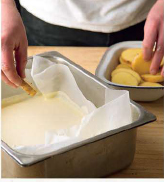
2 Pour the cream into a lined baking sheet.
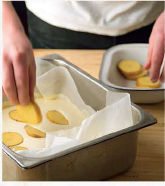
3 Place the potato slices in the cream. Cover with foil and bake in the oven.
Meanwhile, make the batter. Mix the dry ingredients together in a bowl and make a well in the center. Slowly add enough of the mineral water and whisk in until you have a thick smooth batter (see Note).
Once the potatoes have cooled, carefully take the slices out of the cream and layer onto a tray. (Strain the cream and use to make mashed potato.)
Heat the vegetable oil in a deep-fryer to 315°F or in a deep saucepan (no more than one-third full). Carefully dip each potato slice in the batter and deep-fry, in batches, for 2–3 minutes or until golden. Sprinkle with the herb salt and serve straight away.
Note This is my standard batter, which I use for most things. It’s a great recipe to add to your repertoire. For this version, the batter needs to be thick so that it sticks to the potato. If you want to use the batter for other recipes, frying fish or vegetables say, then add a splash more mineral water so it’s not as thick.
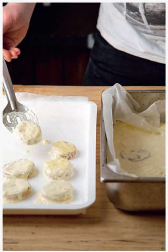
4 Once the potatoes are cooked and have cooled, carefully take the slices out of the cream and layer onto a tray.
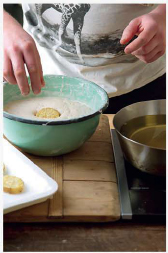
5 Prepare the oil for frying. Dip each potato slice in batter.
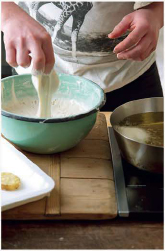
6 Fry scallops in batches until golden.